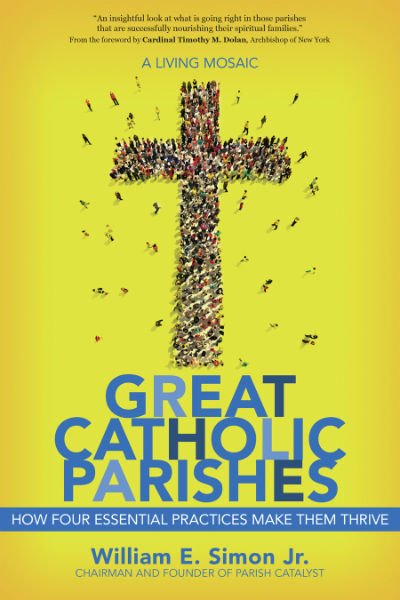
This is the cover of “Great Catholic Parishes: How Four Essential Practices Make Them Thrive” by William E. Simon Jr. The book is reviewed by David Gibson. (CNS)
“Great Catholic Parishes: How Four Essential Practices Make Them Thrive” by William E. Simon Jr. Ave Maria Press (Notre Dame, Indiana, 2016). 202 pp. $17.95.
No single thread connects the Catholic parishes that are vibrant and thriving in the 21st century. “There is no ‘silver bullet’ for doing great parish ministry in the Catholic Church today,” writes William E. Simon Jr.
Still, the research that prompted him to write “Great Catholic Parishes” revealed four important characteristics of these parishes, namely that they “(1) share leadership, (2) foster spiritual maturity and plan for discipleship, (3) excel on Sundays, and (4) evangelize in intentional, structured ways.”
[hotblock]
In 2012 the book’s well-known businessman author, who ran for governor of California in 2002, founded an organization called Parish Catalyst, “devoted to supporting the health and development of Catholic parishes.” This book demonstrates that Simon’s interests stretch well beyond the fields of politics or financial investing.
The book “contains some of the first fruits” of Parish Catalyst’s work by sharing “the self-reported best practices, opportunities and challenges of more than 200 excellent parishes.”
Ultimately, this is a book of good news about “places in the Catholic Church where creativity, vision and devotion have the traction to move the mission of Jesus Christ forward,” Simon writes. He wants it to convey “a message of hope and optimism, grounded in realism” — a message about American parishes “where important and meaningful work is being done every single day and quantifiable progress is being achieved.
A note of caution is attached to this message, however. Current trends indicate Catholics will leave their parishes “in moderate but consistent numbers in the coming decades” and will remain in them only if “given reason to, only if there is something vibrant and life-giving in their parishes,” according to Simon.
He addresses his book to parish priests, deacons, lay and religious order ministers, parish staff and committed volunteers. The book intends to offer “practical ideas and more than a little encouragement” to readers like these.
Parish leadership is among Simon’s main topics of interest here. “There are many different leadership styles,” he observes. However, “one commonality is that good leaders are skilled communicators — individuals who are verbally eloquent, but also able to communicate to others on a deeper level. They articulate a compelling vision and arouse strong emotional support in those they lead.”
There is a shift today toward shared leadership in parishes, and this “represents a marked change from the traditional lone-ranger model of pastoring,” Simon writes. Parish Catalyst researchers, he notes, “identified three different styles of leadership sharing: the collaborators, the delegators and the consultors.”
Highlighting the importance of lay leadership in the American Catholic parish, Simon points out that “teamwork and communication have become essential to decision-making processes.” In fact, he says, “listening to advice from lay leaders means opening up a lane for dialogue — making communication a two-way street.”
Simon is convinced there are “creative, talented and energetic individuals” in our parish pews. “Helping people discover their strengths and how to use them,” he says, “can have a resounding effect on parish life overall.”
The Parish Catalyst team “conducted a total of 244 interviews with pastors from every state in the United States,” Simon explains. The team asked pastors “to reflect on their major challenges and near-term goals, and to share their greatest successes.”
Pastors were asked, as well, “about their leadership styles, their staffs, what gets them up in the morning and where they look for inspiration.”
Not only did the researchers learn what gets pastors up in the morning, but also what keeps them awake at night — what worries them most, which issues they find difficult.
“Great Catholic Parishes,” while fairly brief and easy to read, covers a wide range of issues involved in the creation of parishes that thrive. Most parish leaders should find something in the book that relates directly to their work.
Parish personnel issues and tensions, the hiring of talented ministers, making hospitality a parish reality, parish websites, the challenges of bilingual and multicultural parishes, young-adult ministries, financial matters and the transition surrounding a new pastor’s arrival — all these and many other challenging factors in contemporary parish life are addressed.
The findings of the Parish Catalyst researchers “fit comfortably into four themes: sharing leadership, growing spiritually, worshiping and reaching out,” Simon observes. “To us,” he adds, “these four areas neatly encompass the principal aspects of parish life.”
I suspect Simon’s book soon will appear on reading lists for pastors, parish staffs, parish councils, pastoral planners and, indeed, anyone interested in what it takes to create a great Catholic parish in our times.
***
Also of interest: “The Church Has Left the Building: Faith, Parish and Ministry in the Twenty-First Century, “edited by Michael Plekon, Maria Gwyn McDowell and Elizabeth Schroeder. Cascade Books (Eugene, Oregon, 2016). 141 pp., $ .
“The Rebuilt Field Guide: Ten Steps for Getting Started” by Michael White and Tom Corcoran. Ave Maria Press (Notre Dame, Indiana, 2016). 75 pp., $9.95.
“For a New Generation: A Practical Guide for Revitalizing Your Church” by Lee Kricher. Zondervan (Grand Rapids, Michigan, 2016). 173 pp., $15.99.
***
Gibson was the founding editor of Origins, Catholic News Service’s documentary service. He retired in 2007 after holding that post for 36 years.



Share this story